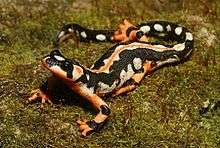Brachycormus
| Brachycormus Temporal range: Upper Oligocene–Middle Miocene, 29.30–15 Ma | |
|---|---|
| Scientific classification | |
| Kingdom: | Animalia |
| Phylum: | Chordata |
| Class: | Amphibia |
| Clade: | Caudata |
| Genus: | †Brachycormus Meyer, 1860 |
| Type species | |
| † Triton noachicus Goldfuss, 1831 | |
Brachycormus is an extinct genus of salamandrid amphibian from the Oligocene–Miocene of Europe.[1]
Neoteny is evident in some larval specimens by the retention of branchial arches and a high degree of ossification in the hyobranchial skeleton. The reason for this neoteny may be explained by a drop in global temperature during the Oligocene cooling event, which may have induced a delay in somatic development in relation to the gonadal development of these animals, thus allowing them to breed at the larval stage and shift the timing of their developmental change to cope with the changes in climate.[2][3]
References
- ↑ Martín, C. & Sanchiz, B. (2014). "Brachycormus Meyer, 1860c". Lisanfos KMS. Version 1.2. Online reference accessible at http://www.lisanfos.mncn.csic.es/. Museo Nacional de Ciencias Naturales, MNCN-CSIC, Madrid (Spain). Retrieved 7 March 2014. External link in
|work=(help) - ↑ Roček, Z. (1995) Heterochrony: response of amphibia to cooling events, Geolines (Praha) 3, pp. 55–58
- ↑ Roček, Z. (1996) The salamander Brachycormus noachicus from the Oligocene of Europe, and the role of neoteny in the evolution of salamanders. Palaeontology 39, 477–495
This article is issued from Wikipedia - version of the 8/28/2016. The text is available under the Creative Commons Attribution/Share Alike but additional terms may apply for the media files.
